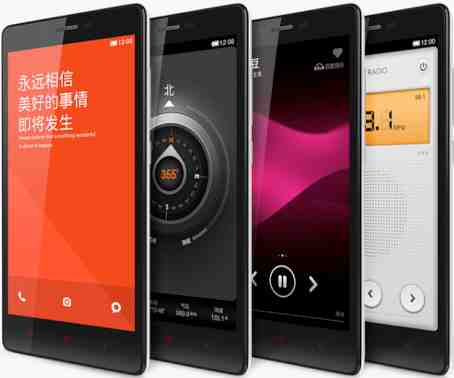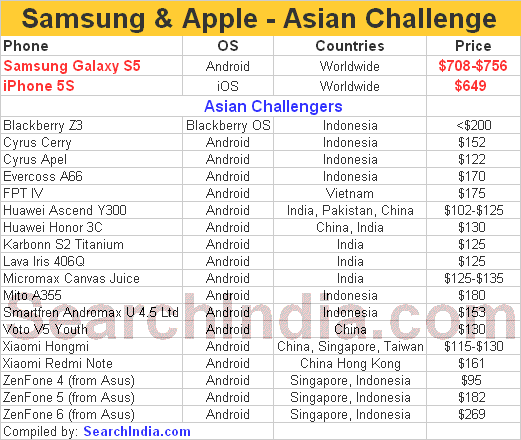Americans and Europeans have been paying through their nose for smartphones, boosting the fortunes of greedy corporations like Apple and Samsung to stratospheric heights.
The latest model of unlocked iPhone or Samsung Galaxy S series smartphones purchased at retail (which few do in the U.S.) will set you back at least $650.
Together, Apple and Samsung account for over 47% of the global smartphone market. All the other major smartphone manufacturers have less than 5% marketshare each.

Xiaomi Redmi Note Phablet – $161
(Pix Courtesy – GSM Arena)
Asia – Different
Americans and Europeans may be jumping on the iPhone and Samsung Galaxy bandwagon but Asians (excluding South Korea, Japan and Hong Kong) are a different kettle of fish.
The low income levels of majority of people in China, India, Thailand, Malaysia, Pakistan, Bangladesh and Sri Lanka plus the frugal culture and absence of carrier subsidies means folks out there will be highly unlikely to buy a smartphone unless it’s around $100-$150.
To cater to the unwashed masses in South Asia and parts of South East Asia, a gaggle of Chinese companies have launched smartphones with prices as low as $95.

With the exception of the Blackberry Z3, all of the low-cost smartphones targeted at Asians are based on Google’s Android software. Most of these Android devices run older versions of the software like Jelly Bean.
But the dai in Mumbai, vegetable seller in Jamshedpur, the housewife in Villupuram or the randi in Karachi couldn’t care less whether her phone runs Jelly Bean or KitKat. All she wants is a cheap phone (preferably nice looking) that will allow her to yak-yak with friends and family and come in handy in boosting the tiny business she runs on the side.
Many of these new low cost smartphones are pretty impressive with fast processors, impressive cameras and decent amount of memory.
For instance, Xiaomi’s new Redmi Note phablet is decked up with a 5.5 inch 720 x 1280 display, a 1.7GHz Octa-core chipset, 2GB RAM, 16GB internal storage, a 13MP camera, 3200mAh battery and Android 4.2.2. And it costs just $161.
So popular is the Redmi Note that last month the Chinese manufacturer sold 100,000 units in 34 minutes. Asian media reports described it as “agonizing 34 minutes” because Xiaomi sold 100,000 units of the cheaper Hongmi smartphones in just four minutes in November 2013.
There are smartphones cheaper than the Xiaomi Hongmi in Asia.
Just the other day, Asus launched its line of ZenFones with prices starting at $95.
Impact on Samsung, Apple
Given the huge price difference between the cheap smartphones flooding the Asian market and devices made by the two Goliaths Apple and Samsung, I wonder how the two titans will surmount the price obstacle.
I do not believe iPhone 5S or the Samsung Galaxy S5 are significantly ahead of a Redmi Note except in some gimmickry features like fingerprint sensor or heartbeat reader.
So the huge price differentials between Samsung/iPhone will be hard to sustain unless there are some radical innovations in their devices. And I don’t see any such innovation on the horizon for either vendor.
Truth be said, the pace of innovation has slowed considerably over the last 18-months at both Apple and Samsung primarily because there’s only so much you can do with a smartphone. And a million iOS and Android apps have already expanded the capabilities of both iPhone and Android devices.
Not many Asians will be willing to pay or can afford to pay $649 for Apple’s iPhone 5S (16GB) or $708-$756 for Samsung’s new Galaxy S5 when a Xiaomi or ZenFone will do the job almost just as well..
Both Apple and Samsung currently enjoy huge profit margins that will be strongly threatened by the Chinese low-cost smartphone invaders.
Can these margins be sustained in the face of the Asian onslaught by Chinese manufacturers? I doubt it!
For instance, the Galaxy S5 costs $256 to build. Even after accounting for development costs, Samsung is raking in a big profit by selling it for $700.
Likewise for Apple.
The IHS teardown analysis for the iPhone 5S (16GB model) estimates the bill of material plus manufacturing costs for the device is $198.70. Again, even after development and other costs are factored in the profit margin for Apple is huge since the retail cost is a whopping $649.
Also, what happens when companies like Xiaomi bring their devices to the U.S. market.
Now you begin to understand why Samsung and Apple are desperately eying new markets like wearables (watches etc).
Say what you will but me thinks Asian consumers are a lot smarter than Americans and Europeans when it comes to getting more bang for their buck from smartphones.

I am thinking that key technical issues that smartphones made engineers think about is energy efficiency and the other being portability.
Also developing for mobile devices puts constraints on how much stuff can be added to the app or web site, think lean and mean websites instead of the bloated sites that were made in the pure pc era.
Going forward it is possible that instead of general purpose devices manufacturers will start making specialized devices highly optimized for a small set of tasks.
For example businesses may want to give their employees such devices to be used for work but not for anything else.
SearchIndia.com Responds:
You write: Going forward it is possible that instead of general purpose devices manufacturers will start making specialized devices highly optimized for a small set of tasks.
Not the American Way!
American culture now demands an all-in-one.